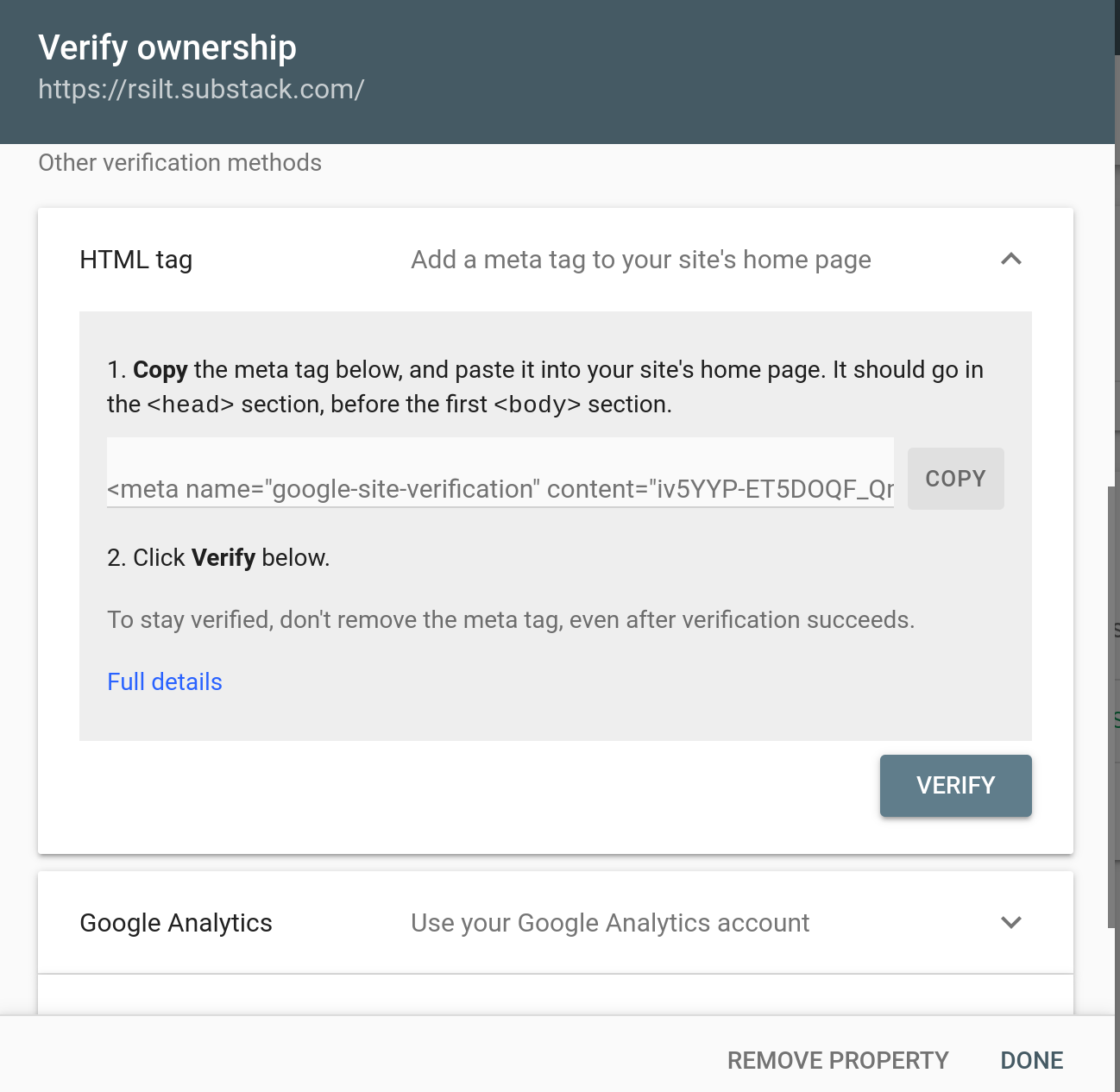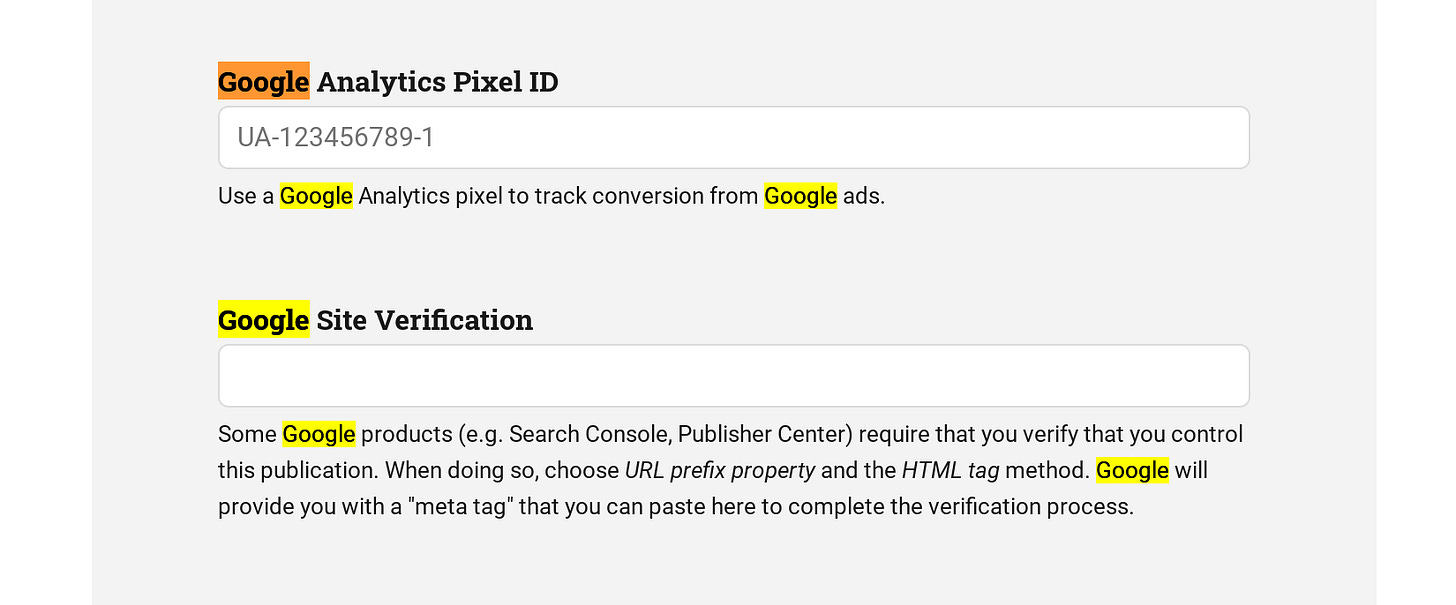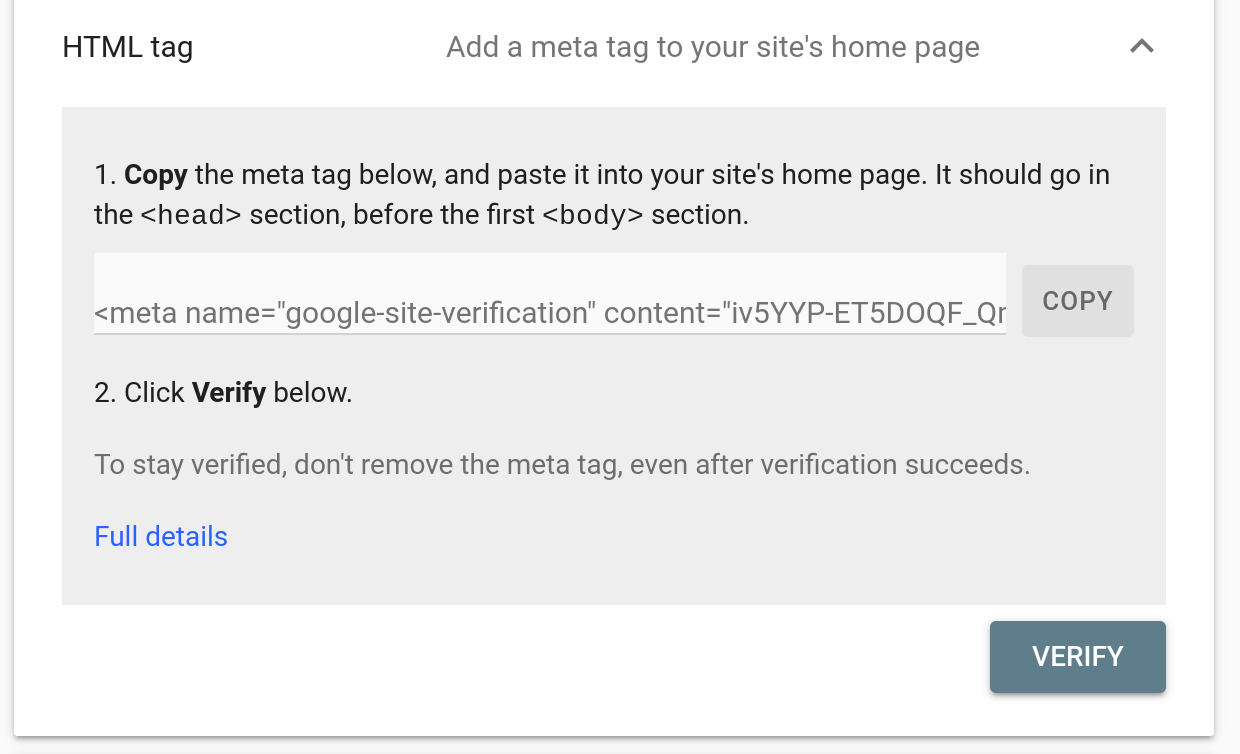How I got my Substack to be Google searchable--and sadly, you probably cannot.
Google won't find your blog unless you tell it where to look and substack won't let you tell it.
Update: why this long post and all the work I put into it may likely not help you.
Update: 8 March 2022
To get your site to be Google Searchable all you had to do was confirm to Google that you owned it, and then provide a sitemap. Substack made it harder to confirm that you owned it—but not impossible. Then substack stopped providing sitemaps.
You can find out if there’s even the tiniest amount of value by looking for your sitemap at
https://<your. blog>/sitmap.xml
If you have a sitemap, great. If not, sorry. Not my fault.
When I wrote this, this blog and another one had sitemaps. Not any more. Neither does this one, whose author asked me for help. (Click on the sitemap URL, and you’ll get an error.)
Well trafficked sites like this one generate sitemaps like this one. But if you’re a small site, it seems that you’re out of luck.
I’ve been back and forth Substack support after I managed to authenticate with Google Tag Manager and discovered no sitemap. They have all been nice, but all say the same thing: promote it on social media or put links on your site, or whatever and get enough traffic and that may lead Google to index.
And maybe if you get famous enough, Substack will generate a sitemap.xml and you can get your whole site indexed. But otherwise you’re out of luck.
If you are really determined you can authenticate with Tag Manager or Analytics (this post does not tell you how) and then you can use Search Consolue to manually ask Google to index each page.
I did a trial with Ghost.com and tried exporting and importing and doing the stuff that was needed and it worked! Absolutely worked. Better than substack ever did.
Substack is free and Ghost is not. It’s $10/ a month for the low tier of subscribers, but to index you have to authenticate and to authenticate you have to customize and if you customize that puts you in the $25.00 per month tier. If that’s not too much for you, go Ghost. It’s too much for me at this time.
I can only suggest that people complain, complain, complain until they fix it or provide an alternative.
Step 4 is the one that NO LONGER WORKS because Substack has removed the Google Site Verification method.
Complain. Sorry. Best I can do. I’ll keep trying.
Introduction
This post will appear on the blog rsilt.substack.com.
I moved the 211 posts I’d written at Blogspot (rsilt.blogspot.com) to substack. It was easy. But weeks later, here’s what Google returns when I search for everything they had indexed. The search string is: “site:rsilt.substack.com”
Nothing. Zero. Nada. Or, as we say in New York, not a fucking thing.
I thought that creating a blog on substack would get it indexed automagically.
It doesn’t.
I also thought it would happen automagically on Blogspot. Supposedly it does, but it appears that it didn’t.
So here’s what I had to do. (And what you will need to do)
1. Go to the Google Search Console
Don’t know what that is? Go to this website:
https://search.google.com/search-console/about
Or Google for “Google Search Console”
You’ll see something like this:
Click “Start Now” and sign in with your Google account.
2. Register your property
Once you’ve signed in, Google will prompt you to register your property. If this isn’t your first rodeo, you’ll see something like this (only with the properties you’ve already registered added).
If you click on “Add property,” you’ll see what you’d see if you have no properties registered yet. Something like this:
If you are a domain owner, you can register the domain. If not (and even if yes), you can register a URL prefix for a subset of the domain.
Unless you happen to own substack.com, you’ll be registering your substack URL prefix.
In this case, I want to register the URL prefix for this blog:
https://rsilt.substack.com
3. Verify ownership: get the code
Search Console will ask you to verify ownership of the domain. There are several ways to do this. The recommended technique is to download a magical HTML file and upload it to the site. But substack doesn’t let you do that. So you’ll have to go to the section at the bottom where it says “Other verification methods.”
There are several. We’re going to use the HTML tag verification method, first on the list.
Clicking on the down arrow gives you these instructions:
If you click on the Copy button, you’ll get something like this in your clipboard:
<meta name="google-site-verification" content="iv5YYP-ET5DOQF_QmKh9Wrfd9Qq45eD30vk58BR8v_R1Y" />
All you need is the string following
content=
In this case, it’s
iv5YYP-ET5DOQF_QmKh9Wrfd9Qq45eD30vk58BR8v_R1Y
4. Verify ownership: configure substack
Go to your substack dashboard, then choose "Settings.”
When you click on Settings, you’ll get a loooooong page with lots of settings. Search (Ctrl-F on Window, Cmd-F on Mac) for “Google”
That will take you to this part of the settings page:
Here you’ll want to paste your site verification code:
And then click Save to save it.
5. Verify ownership: Complete at the console
Back to the Search Console, where you got the verification code. Click on VERIFY
And if you’ve done it correctly, you’ll see something like this:
5. Add a sitemap
Go to the property and add a sitemap. The sitemap for rsilt.substack.com is here:
https://rsilt.substack.com/sitemap.xml
If you put that in your browser bar, you’ll see a page that looks like this:
You can see a list of URLs and their change frequencies. The archive page is checked daily—the About page weekly. And individual posts monthly. That means that if you update a post, it might not be reindexed for a month. If you need it to be reindexed, there’s a way to tell Google to do that. But first, let’s add the sitemap.
Chose the property
Click on Sitemaps
Enter the sitemap URL (sitemap.xml)
Click SUBMIT
You should see a message this:
And the sitemap section should look something like this:
6. Check back later—way later
If you go to the Overview section for the property, you’ll see something like this:
It will stay that way for a while—maybe three or four days. Then stuff will appear.
To hurry it up, you might tell Google to index a particular page RIGHT NOW!
7. How to index a specific page
You might want to index a page to check things out. It still takes time, but less time.
You might also want to index a page if you make significant enough changes that the page would be indexed differently.
So here’s how.
You use the URL inspection tool and put the URL in the search box.
Press ENTER, and Google will check out the URL.
If you choose REQUEST INDEXING, you’ll get a message like this:
7. How to see what a page looks like to Google’s crawler
If you choose TEST LIVE URL, you can see what the page looks like. For example, the archive page looks like this:
That’s fine. Looks good.
To see more, choose VIEW TESTED PAGE.
A sidebar will pop up that lets you look at the HTML or a screenshot. Here’s the screenshot for the archive page.
As you can see, the screenshot shows nothing useful, which is useful to know.
Summary
You need to tell Google about your blog.
You will need to tell Bing.
You will need to tell Duck Duck Go.
You will need to tell all the other search engines.
Or you can just tell Google.























I don't know. I've given up myself
Hi, Michael. I just wanted to drop in to thank you for these incredibly clear and easy to follow instructions. They worked like gangbusters for me. I really appreciate how much work went into creating this post.